Статьи журнала - International Journal of Image, Graphics and Signal Processing
Все статьи: 1056
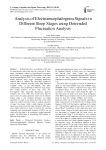
Статья научная
Scaling behavior is an indicator of the lack of characteristic time scale, and the existence of long-range correlations related to physiological constancy preservation. To investigate the fluctuations of the sleep electroencephalogram (EEG) over various time scales during different sleep stages detrended fluctuation analysis (DFA) is studied. The sleep EEG signals for analysis were obtained from the Sleep-EDF Database available online at the PhysioBank. The DFA computations were performed in different sleep stages. The scaling behavior of these time series was investigated with detrended fluctuation analysis (window size: 50 to 500). The results show that the mean values of scaling exponents were lower in subjects during stage 4 and standard deviation of scaling exponents of stage 4 was larger than that of the other stages. In contrast, the mean value of scaling exponents of stage 2 was larger, while a small variation of scaling exponent is observed at this stage. Therefore, DFA has a more stable behavior in stage 2, whereas the random variability and unpredictable behavior of DFA can be observed in the stage 4. In conclusion, scaling exponent indices are efficacious in quantifying EEG signals in different sleep stages.
Бесплатно
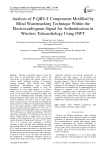
Статья научная
Presently considerable amount of work has been done in tele-monitoring which involves the transmission of bio-signals and medical images in the wireless media. Intelligent exchange of bio-signals amongst hospitals needs efficient and reliable transmission. Watermarking adds “ownership” information in multimedia contents to prove the authenticity, to verify signal integrity, or to achieve control over the copy process. This paper proposes a novel session based blind watermarking method with secret key by embedding binary watermark image into (Electrocardiogram) ECG signal. The ECG signal is a sensitive diagnostic tool that is used to detect various cardio-vascular diseases by measuring and recording the electrical activity of the heart in exquisite detail. The first part of this paper proposes a multi-resolution wavelet transform based system for detection ‘P’,‘Q’,‘R’,‘S’,‘T’ peaks complex from original ECG signal of human being. ‘R-R’ time lapse is an important component of the ECG signal that corresponds to the heartbeat of the concerned person. Abrupt increase in height of the ‘R’ wave or changes in the measurement of the ‘R-R’ interval denote various disorders of human heart. Similarly ‘P-P’, ‘Q-Q’, ‘S-S’, ‘T-T’ intervals also correspond to different disorders of heart and their peak amplitude envisages other cardiac diseases. In this proposed method the ‘P Q R S T’-peaks are marked and stored over the entire signal and the time interval between two consecutive ‘R’-peaks and other peaks interval are measured to detect anomalies in behavior of heart, if any. The peaks are achieved by the composition of Daubechies sub-bands wavelet of original ECG signal. The accuracy of the P, QRS and T components detection and interval measurement is achieved with high accuracy by processing and thresholding the original ECG signal. The second part of the paper proposes a Discrete Wavelet Transformation (DWT) and Spread Spectrum based watermarking technique. In this approach, the generated watermarked signal having an acceptable level of imperceptibility and distortion is compared to the Original ECG signal. Finally, a comparative study is done for the intervals of two consecutive ‘R-R’ peaks, ‘P-R’, ‘Q-T’, ‘QTc’, QRS duration, cardiac output between original P, QRS and T components detected ECG signal and the watermarked P,QRS and T components detected ECG signal.
Бесплатно
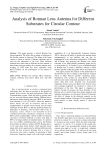
Analysis of Rotman Lens Antenna for Different Substrates for Circular Contour
Статья научная
This paper presents a trifocal Rotman lens design approach. The effect due to change of substrate on the circular contour is observed. The shape of the beam contour is taken as circular. Different substrates can be used for the fabrication of the lens. Three different materials have been used to fabricate the lens antenna .A three beam prototype feeding five element antenna array working in ISM band has been simulated using RLD1.7.Effects on the performance of the antenna is observed.
Бесплатно
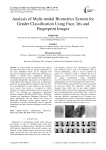
Статья научная
A certain number of researchers have utilized uni-modal bio-metric traits for gender classification. It has many limitations which can be mitigated with inclusion of multiple sources of biometric information to identify or classify user’s information. Intuitively multimodal systems are more reliable and viable solution as multiple independent characteristics of modalities are fused together. The objective of this work is inferring the gender by combining different biometric traits like face, iris, and fingerprints of same subject. In the proposed work, feature level fusion is considered to obtain robustness in gender determination; and an accuracy of 99.8% was achieved on homologous multimodal biometric database SDUMLA-HMT (Group of Machine Learning and Applications, Shandong University). The results demonstrate that the feature level fusion of Multimodal Biometric system greatly improves the performance of gender classification and our approach outperforms the state-of-the-art techniques noticed in the literature.
Бесплатно
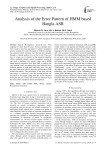
Analysis of the Error Pattern of HMM based Bangla ASR
Статья научная
Speech Recognition research has been ongoing for more than 80 years. Various attempts have been made to develop and improve speech recognition process around the world. Research on ASR by machine has attracted much attention over the last few decades. Bengali is largely spoken all over the world. There are lots of scopes yet to explore in the research regarding offline automatic Bangla speech recognition system. In our work, a moderate size speech corpus and a HMM based speech recognizer have been built to analyze the error pattern. Audio recordings have been collected from different persons in both quiet and noisy area. Live test has been carried out also to check the performance of the model individually. The percentage of the error and the percentage of correction with the created models are presented in this paper along with the results obtained during the live test. Finally, the results are analyzed to get the error pattern needed for future development.
Бесплатно
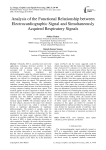
Статья научная
Clinically, ECG is a potential tool used in the applications evaluating electrical activities of heart, functioning and providing solution to problems associated with it. Among such, the relationship (correlation) between respiration and electrocardiographic signal has attracted attention in past decades. In this research, a Welch spectrum estimation approach was utilized for normalizing cross spectrum analysis between these two signals. This approach can be useful while diagnosing diseases like pulmonary embolism, coronary lung diseases, Deep vein thrombosis and other diseases related to heart, from the knowledge of existing coherence bonding between these signals. This research applies the above approach to human subjects, whose ECG and respiratory signal annotations has been evaluated and were sampled at 100 samples/ second (sampling rate). The different respiratory signals are taken from Chest (CRSP), abdominal (ARSP) and oronasal regions (NRSP). The annotated signals for all the four subjects, discussed in this paper were obtained through a non-invasive test, which is medically well known as impedance phlebography, or impedance plethysmography. The numbers of samples, under the analysis were 6000 for each signal. The data was acquired from recording database of physionet. For this examination the mean square coherence (MSC) was chosen as an excellent candidate. The results imply that the mean of MSCs is found continuously decreasing in chest respiration. Secondly, the results showed maximum coherence between ECG and corresponding respiratory signal in three subjects is in Abdominal (ARSP) region (i.e. having maximum value greater than 0.5). Lastly, above analysis was analyzed over the fourth subject's data and under observation it was found, exceptionally that, the value of coherence for all respiratory patterns showed a poor functional association or simply coherence between the signal i.e.Coh2 below 0.5 in the abdominal region (ref.Fig.5) and the reason suggested could be chronic lung disease while the results show higher values, that is between (0.5 < coherence <1) in other two. Further, we show that the coherence peak reflects that the one physiological signal is synchronized with another signal of same nature at a particular frequency, here it is 0 to 35 Hz frequency band and combined analysis is shown through a Boxplot, from three regions showing maximum value of coherence upper quartile in abdominal region for three healthy subjects with maximum value of peak in the same region. This paper also presents a platform to dissolve the problem pertaining in an individual related to deep vein thrombosis, hypoxemia (blood level <90%) [16] and related diseases by estimating the coupling associated between saturated oxygen content (SO2) with respiratory patterns, in order to detect dysfunctioning clinically, also for efficient heart working. Thus, the research shows successful attempt to investigate the interaction of the PS of ECG signal and respiratory signals. The work presented in this paper can further be extended by adopting different method and either by defining a vector array element for maximum number of coherence value that could be beneficial for detecting diseases like sleep apnea on basis of minimum or maximum occurrence of peaks.
Бесплатно
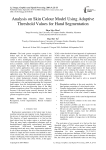
Analysis on skin colour model using adaptive threshold values for hand segmentation
Статья научная
The hand gesture recognition system is the hottest topic for the human-machine interaction and computer vision fields. The hand gesture recognition system is still a challenging research area in computer vision for human-computer interaction because of various device conditions, various illumination effects, and very complex background. The recognition of hand gestures used in various application areas: such as sign language recognition, man-machine interaction, human-robot interaction, and intelligent device control and many other application areas. The robust detection of hand in hand gesture recognition system has become a challenging task due to clutter background, dynamic background, and various illumination conditions in real-world conditions. Segmentation is the partioning/separating the foreground hand region from the background region in an image. Segmentation is also pre-processing steps of the hand gesture recognition system. The recognition accuracy will increase if the hand region correctly detected. So, hand region detection is the main important step for the hand gesture recognition system.
Бесплатно
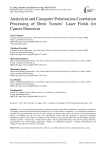
Статья научная
A new local-topological approach to describe the spatial and angular distributions of polarization parameters of multiply scattered optically anisotropic biological layers of laser fields is considered. A new analytical parameter to describe the local polarization structure of a set of points of coherent object fields, the degree of local depolarization (DLD), is introduced for the first time. The experimental scheme and the technique of measuring coordinate distributions (maps) of DLD The new method of local polarimetry was experimentally tested on histological specimens of biopsy sections of operatively extracted breast tumors. The measured DLD maps were processed using statistical, autocorrelation and scale-sampling approaches. Markers for differential diagnosis of benign (fibroadenoma) and malignant (sarcoma) breast tumors were defined.
Бесплатно
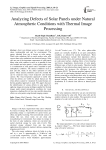
Analyzing defects of solar panels under natural atmospheric conditions with thermal image processing
Статья научная
Sun is an ultimate source of energy, which is clean, inexhaustible and safe for environment. The energy obtained from sun is known as solar energy. When solar radiations fall on earth surface solar cells convert these solar radiations into electrical energy. Solar cells are one of the important components of solar panels. Many solar cells combine in series or in parallel to form solar module and solar panels. A solar photovoltaic array is a combination of solar panels and is installed in open atmospheric condition. The natural conditions such as dust and dirt, shade of tree affect operation of solar panels. These natural conditions cannot be avoided but can be analyzed using visual inspection and thermal camera. The visual inspection approach is useful only when the defects are visible by naked human eye but when defects cannot be visualized by naked human eye thermo-graphical approach is used. This paper discusses the identification of various defects in solar panels by applying image processing technique applied for thermal images under natural atmospheric conditions for visual inspection, shading effect of tree, dust and dirt deposition effects on solar panels using thermal imaging camera.
Бесплатно
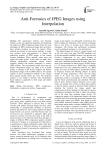
Anti-Forensics of JPEG Images using Interpolation
Статья научная
The quantization artifacts and blocking artifacts are the two significant properties for identifying the forgery in a JPEG compressed image. There are some techniques for JPEG compressed images that can remove these artifacts resulting no traces for forgery. These methods are referred as anti-forensic methods. A forger may perform some post-operations to disturb the underlying statistics of JPEG images to fool current forensic techniques. These methods create noise and reduce the image quality. In this paper we apply three different interpolation techniques namely nearest neighbor, bilinear and bicubic techniques to remove JPEG artifacts. The experimental results show that the bicubic interpolated images are found to be of better quality as compare to the nearest neighbor and bilinear interpolated images with no JPEG artifacts. For quality analysis of these interpolation methods on the images three popular quality metric are used. The proposed method is very simple to perform. This interpolation based method is applicable to both single and double JPEG compression.
Бесплатно
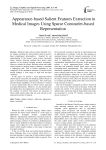
Статья научная
Medical experts often examine hundreds of x-ray images searching for salient features that are used to detect pathological abnormalities. Inspired by our understanding of the human visual system, automated salient features detection methods have drawn much attention in the medical imaging research community. However, despite the efforts, detecting robust and stable salient features in medical images continues to constitute a challenging task. This is mainly attributed to the complexity of the anatomical structures of interest which usually undergo a wide range of rigid and non-rigid variations. In this paper, we present a novel appearance-based salient feature extraction and matching method based on sparse Contourlet-based representation. The multi-scale and directional capabilities of the Contourlets is utilized to extract salient points that are robust to noise, rigid and non-rigid deformations. Moreover, we also include prior knowledge about local appearance of the salient points of the structure of interest. This allows for extraction of robust stable salient points that are most relevant to the anatomical structure of interest.
Бесплатно
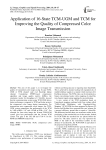
Статья научная
The aim of this paper is to investigate the quality of transmitted color images using 16-state TCM-UGM or TCM channel code over Rayleigh fading channel. Considering SPIHT-based compression algorithm and image quality metrics (IQMs), the simulation results for throughput of 2 bit/s/Hz, showed that the communication system using TCM-UGM allows better performance compared to TCM and better protects the compressed color image during transmission. For transmission tests compressed colors images, the TCM-UGM system outperforms the performance of the TCM by 3 dB at BER = 10-5 and 4.59 dB at FER = 3.10-3. For example, for Lena color image, the 16-state TCM-UGM system gives best performance that the 16-state TCM system. The gain is the 5.02 dB and 17.90 % for the PSNR and MMSIM respectively.
Бесплатно
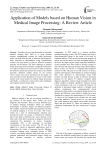
Application of Models based on Human Vision in Medical Image Processing: A Review Article
Статья научная
Nowadays by growing the number of available medical imaging data, there is a great demand towards computational systems for image processing which can help with the task of detection and diagnosis. Early detection of abnormalities using computational systems can help doctors to plan an effective treatment program for the patient. The main challenge of medical image processing is the automatic computerized detection of a region of interest. In recent years in order to improve the detection speed and increase the accuracy rate of ROI detection, different models based on the human vision system, have been introduced. In this paper, we have provided a brief description of recent works which mostly used visual models, in medical image processing and finally, a conclusion is drawn about open challenges and required research in this field.
Бесплатно
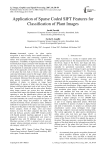
Application of Sparse Coded SIFT Features for Classification of Plant Images
Статья научная
Automated system for plant species recognition is need of today since manual taxonomy is cumbersome, tedious, time consuming, expensive and suffers from perceptual biasness as well as taxonomic impediment. Availability of digitized databases with high resolution plant images annotated with metadata like date and time, lat long information has increased the interest in development of automated systems for plant taxonomy. Most of the approaches work only on a particular organ of the plant like leaf, bark or flowers and utilize only contextual information stored in the image which is time dependent whereas other metadata associated should also be considered. Motivated from the need of automation of plant species recognition and availability of digital databases of plants, we propose an image based identification of species of plant when the image may belong to different plant parts such as leaf, stem or flower, fruit , scanned leaf, branch and the entire plant. Besides using image content, our system also uses metadata associated with images like latitude, longitude and date of capturing to ease the identification process and obtain more accurate results. For a given image of plant and associated metadata, the system recognizes the species of the given plant image and produces an output that contains the Family, Genus, and Species name. Different methods for recognition of the species are used according to the part of the plant to which the image belongs to. For flower category, fusion of shape, color and texture features are used. For other categories like stem, fruit, leaf and leafscan, sparsely coded SIFT features pooled with Spatial pyramid matching approach is used. The proposed framework is implemented and tested on ImageClef data with 50 different classes of species. Maximum accuracy of 98% is attained in leaf scan sub-category whereas minimum accuracy is achieved in fruit sub-category which is 67.3 %.
Бесплатно
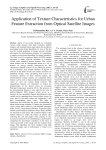
Application of Texture Characteristics for Urban Feature Extraction from Optical Satellite Images
Статья научная
Quest of fool proof methods for extracting various urban features from high resolution satellite imagery with minimal human intervention has resulted in developing texture based algorithms. In view of the fact that the textural properties of images provide valuable information for discrimination purposes, it is appropriate to employ texture based algorithms for feature extraction. The Gray Level Co-occurrence Matrix (GLCM) method represents a highly efficient technique of extracting second order statistical texture features. The various urban features can be distinguished based on a set of features viz. energy, entropy, homogeneity etc. that characterize different aspects of the underlying texture. As a preliminary step, notable numbers of regions of interests of the urban feature and contrast locations are identified visually. After calculating Gray Level Co-occurrence matrices of these selected regions, the aforementioned texture features are computed. These features can be used to shape a high-dimensional feature vector to carry out content based retrieval. The insignificant features are eliminated to reduce the dimensionality of the feature vector by executing Principal Components Analysis (PCA). The selection of the discriminating features is also aided by the value of Jeffreys-Matusita (JM) distance which serves as a measure of class separability Feature identification is then carried out by computing these chosen feature vectors for every pixel of the entire image and comparing it with their corresponding mean values. This helps in identifying and classifying the pixels corresponding to urban feature being extracted. To reduce the commission errors, various index values viz. Soil Adjusted Vegetation Index (SAVI), Normalized Difference Vegetation Index (NDVI) and Normalized Difference Water Index (NDWI) are assessed for each pixel. The extracted output is then median filtered to isolate the feature of interest after removing the salt and pepper noise present, if any. Accuracy assessment of the methodology is performed by comparing the pixel-based evaluation on the basis of visual assessment of the image and the resultant mask image. This algorithm has been validated using high resolution images and its performance is found to be satisfactory.
Бесплатно
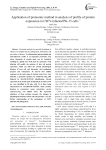
Статья научная
Proteomic analysis is a powerful technology to enhance our insight into the pathogenesis, biomarkers and prevention of disease. Two-dimensional polyacrylamide gel electrophoresis (2-DE) is an important proteomics tool, where thousands of protein spots can be visualized, resulting in a global view of the state of a proteome. Viral infection will modify the patterns of host cell protein expression, which can affect the normal physiological function of host cell and determine viral pathogenic progress and consequence. To uncover host cellular responses in the early stage of classical swine fever virus infection, a proteomic analysis was conducted using 2DE followed by MALDI-TOF-TOF identification. Altered expression of 21 protein spots in infected pk-15 cells at 24 h p.i. were identified in 2D gels, with 13 of these being characterized by MALDI-TOF-MS/MS. These proteins function in cytoskeletal, energy metabolism, nucleic acid/processing, and cellular stress. The expression alteration of these proteins presents the changes in physiological functions of host cells and provides a clue for further understanding of the mechanisms of CSFV infection and pathogenesis.
Бесплатно
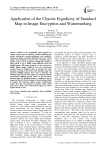
Application of the Chaotic Ergodicity of Standard Map in Image Encryption and Watermarking
Статья научная
Thanks to the exceptionally good properties in chaotic systems, such as sensitivity to initial conditions and control parameters, pseudo-randomness and ergodicity, chaos-based image encryption algorithms have been widely studied and developed in recent years. Standard map is chaotic so that it can be employed to shuffle the positions of image pixels to get a totally visual difference from the original images. This paper proposes two novel schemes to shuffle digital images. Different from the conventional schemes based on Standard map, we disorder the pixel positions according to the orbits of the Standard map. The proposed shuffling schemes don’t need to discretize the Standard map and own more cipher leys compared with the conventional shuffling scheme based on the discretized Standard map. The shuffling schemes are applied to encrypt image and disorder the host image in watermarking scheme to enhance the robustness against attacks. Experimental results show that the proposed encryption scheme yields good secure effects. The watermarked images are robust against attacks as well.
Бесплатно
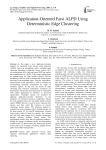
Application-Oriented Farsi ALPD Using Deterministic Edge Clustering
Статья научная
In this paper a new application-oriented method for automatic Farsi license plate detection (ALPD), based on morphology and a modified edge clustering algorithm is proposed. Access control (AC), law enforcement (LE), and road patrol (RP) are mainly three applications for ALPD. After image enhancement by preprocessing, the edge statistics analysis and the morphology filter are used to decrease the search regions and remove the unwanted edges. Then the expectation-maximization (E-M) algorithm is used to estimate the corresponding Gaussian components for edges of remained regions. In this way the results of edge clustering and Gaussian components estimation are deterministic whereas the processing time in comparison with similar approaches in literature, is decreased significantly. Candidate regions are obtained by applying application-oriented thresholds to the properties of estimated Gaussian components. Finally for each candidate region, the maximally stable extremal region (MSER) detector is used to detect character-like regions and then select the region(s) of interest containing license plates. The proposed method is evaluated by using a database which includes images for the three groups AC, LE and RP applications, whereas some images suffer of being low quality, low contrast and blur and some images have complex background through existing multiple license plates. The experimental results show that our proposed method is reliable for images of different quality and illumination condition and it is able to detect the rotated and skewed license plates even in images containing multiple license plates and complex backgrounds.
Бесплатно
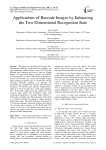
Applications of Barcode Images by Enhancing the Two-Dimensional Recognition Rate
Статья научная
The paper not only proposed the latest Two-Dimensional Barcodes Image-processing Module, but also captured the smallest camera screens (320 240) with different focal distances and tried to find out “Finder Pattern” for positioning images. Further, use CROBU (Conversion Ratio of Basic Unit) the thesis proposed to convert 2-D barcodes into 1-pixel ratio to match images before judging recognition rate of 2-D barcodes through matching. Normally speaking, 2-D barcodes are deciphered and recognized by software while the thesis recognizes 2-D barcodes and enhances implementation speed up to 10-cm accurate max. using image matching. The 2-D barcodes image-processing module the thesis proposed does capture and standardize image with complicated background or raw edge, which enhances 2-D barcodes recognition rate. The main point of this study is to construct a platform to manage or suggest nutrients human body needs. The Quick Response Code image of 2-D barcodes represents vitamin and calories information. 2-D barcodes taken instantly by MATLAB and CCD camera can be used to list nutrients from foods you eat recently and suggest what else you should eat for the purpose of health management.
Бесплатно
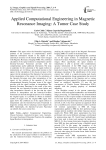
Applied Computational Engineering in Magnetic Resonance Imaging: A Tumor Case Study
Статья научная
This paper solves the biomedical engineering problem of the extraction of complementary and/or additional information related to the depths of the anatomical structures of the human brain tumor imaged with Magnetic Resonance Imaging (MRI). The combined calculation of the signal resilient to interpolation and the Intensity-Curvature Functional provides with the complementary and/or additional information. The steps to undertake for the calculation of the signal resilient to interpolation are: (i) fitting a polynomial function to the signal, (ii) the calculation of the classic-curvature of the signal, (iii) the calculation of the Intensity-Curvature term before interpolation of the signal, (iv) the calculation of the Intensity-Curvature term after interpolation of the signal, (v) the solution of the equation of the two aforementioned Intensity-Curvature terms of the signal provides with the signal resilient to interpolation. The Intensity-Curvature Functional is the result of the ratio between the two Intensity-Curvature terms before and after interpolation. Because of the fact that the signal resilient to interpolation and the Intensity-Curvature Functional are derived through the process of re-sampling the original signal, it is possible to obtain an immense number of images from the original MRI signal. This paper shows the combined use of the signal resilient to interpolation and the Intensity-Curvature Functional in diagnostic settings when evaluating a tumor imaged with MRI. Additionally, the Intensity-Curvature Functional can identify the tumor contour line.
Бесплатно

